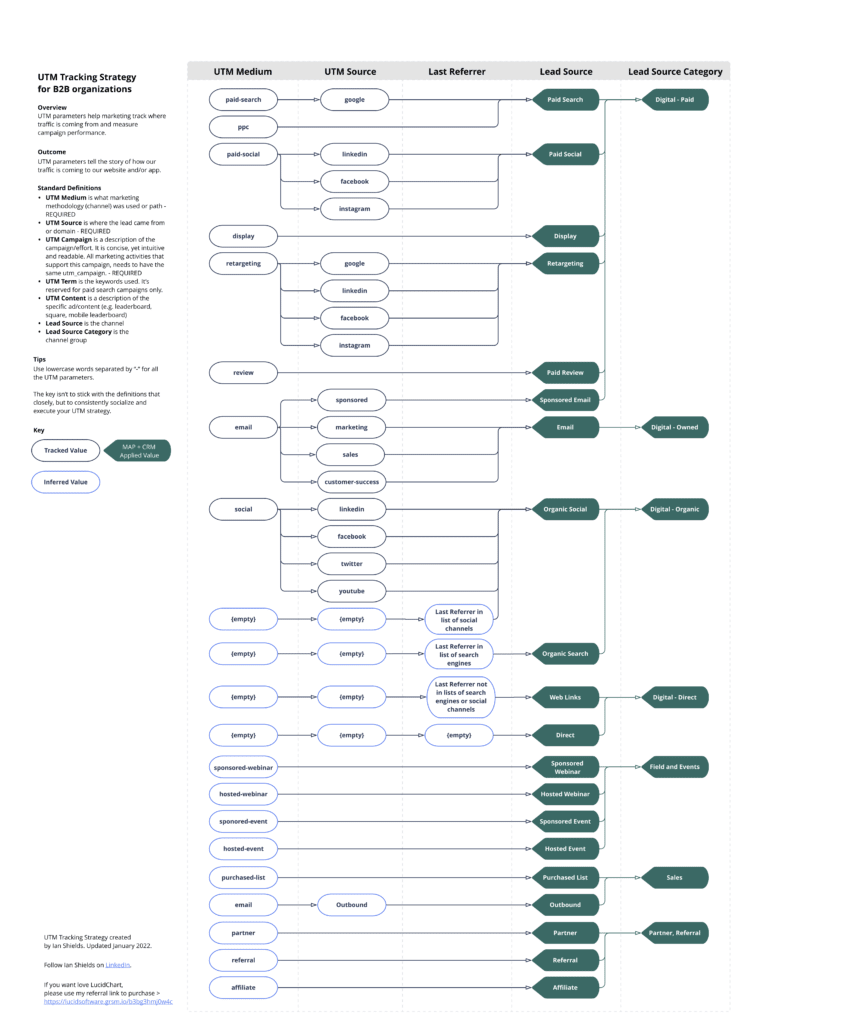UTMs, when implemented properly, are one of the most effective ways to understand campaign performance and traffic attribution.
For marketers, these tracking links generate important data about the source of their website traffic and which which campaigns are driving the most conversions. And for other teams within the broader organization, they provide important context for how users engage with their brand, content, and assets, turning numbers into a story that helps showcase the marketing team’s contributions to pipeline and revenue.
But in order for this story to be a good one, it’s imperative to have an established and consistently-followed UTM strategy in place. Creating this early on in your UTM journey and sticking to it minimizes the confusion your team faces later on, when variations in spelling and capitalization, inconsistent use, and improper field attribution wreaks havoc on the data you collect from them.
Ian Shields, Director of Marketing Operations and Demand Generation at EcoVadis, joined Stack Moxie for a webinar to share his process for creating a solid UTM strategy—and the chart that holds it all together.
To watch the full webinar, find the recording on our YouTube channel.
Building UTMs: The basics
There are plenty of UTM builders out there that can help you set up the proper format for your UTMs.
(In case you missed it, Stack Moxie has a free UTM builder that was created to make it easy to build and follow a strategy like Ian’s.)
To start, it’s important to identify the fields that you will always fill in to identify where traffic is coming from. These include:
- Medium: The channel a user enters through (e.g. display, paid search, or social, among others).
- Source: The original point where the traffic originated (e.g. Google, LinkedIn, or Instagram).
- Campaign: The specific marketing campaign that this link is supporting.
- Term: The keyword used (Usually only used for UTMs for paid search).
- Content: A description of the specific ad or content (e.g. leaderboard, square, or mobile leaderboard).
Generally, UTM medium and UTM source are required for every tracking link you create. These are perhaps the two most important pieces of information you can get from a tracking link, since they tell you how and where a visitor found your content.
The campaign field should be included whenever you’re using UTMs to support a specific campaign—and each UTM that supports the same campaign should have an identical input for this field to maintain consistency.
Term and content are normally optional, and may be useful if you have a dedicated channel manager or demand generation manager who wants to drill deeper into how traffic is being acquired.
Ultimately, it’s important to decide with your team which fields are required, and ensure that every UTM has the proper information to tell the full story of how a user is interacting with your content.
UTM best practices
It’s great if your entire team is making sure each field is appropriately filled in a UTM, but seemingly minor inconsistencies in spelling and capitalization can impact how useful the data from your tracking links is. Here are some guidelines to make sure your UTMs are clean and effective.
- Always use lowercase letters. Making this decision means that you don’t need to worry later on about dealing with varying letter cases or setting up an automation to normalize different capitalization conventions.
- Separate words with hyphens or underscores. This makes words easier to read, which makes for clearer data.
- If you’re using lists from sponsored vendors, create unique UTMs for each vendor. This way, you can see how their lists are converting and have a better understanding of the value they bring.
- Find a system that works for you. At the end of the day, the best UTM strategy is the one that allows you and your team to understand traffic acquisition and make better decisions using that information. If you’re a one-person show, it can be difficult to create and follow through on a very intricate UTM strategy. Getting helps from sales, demand generation, and other stakeholders makes it easier to manage.
- Continue to communicate your UTM strategy so others are aware and can help you build it into each marketing and revenue process. Don’t limit your use of tracking links to QLs or MQLs—instead, look for ways to carry UTM parameters all the way through to pipeline and revenue. That conversation is far more interesting for sales and executive teams to learn about how different sources are converting and where their efforts are best spent.
The end goal of UTMs
Marketing may understand the nuances between email marketing and social media, or LinkedIn and Instagram—but other teams may not. The goal is to group things into categories that make it simpler to explain how different mediums and sources are converting, and provide a clear bottom line for how your organization feeds its audience.
For your marketing team, it’s much more effective to comb through your strategy when you have a clear grasp of how certain sources and mediums affect demo requests and pipeline. When you get even more specific with the fields you include, you can gain better insight into exactly which campaigns are performing best and what terms are leading users to find and click on your content.
For sales, they may care less about dissecting specific sources or mediums, but instead benefit from understanding how a certain channel affects demo requests. And for leadership, you have compelling data to back up the performance of your marketing activities and explain how different sources and mediums are driving pipeline.
Create a beautiful link tracking strategy of your own
Find Ian’s chart below, or find it on Lucidchart to start building your own strategy.
Click here to visit Lucidchart.

Get started with a free Stack Moxie account today.
